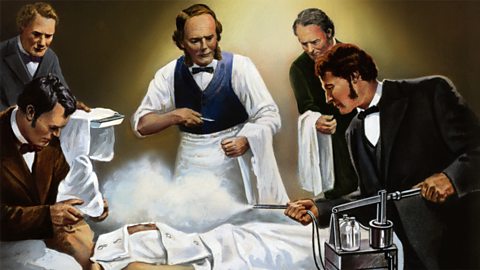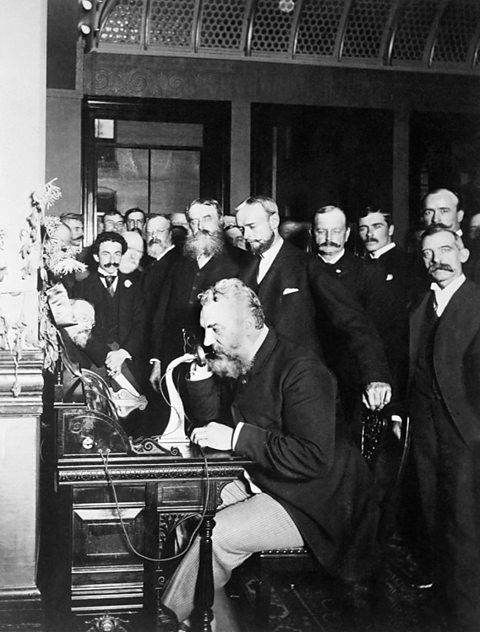Key points
- Queen Victoria ruled the United Kingdom from 1837 - 1901.
- The Victorian period was a period of great social change in England, and of an expanding empire abroad.
- There were lots of new discoveries, inventions and technological developments.
- However, not everyone benefitted equally from these changes.
Activity - What job would you have had in the Victorian era?
Game - working in the mills
Play a History Detectives mission exploring the harsh conditions of children working in the mills.
You can also play the full game.
Overview of the Victorian period
The Victorian period (1837 - 1901) was a time of growing industrialisationA change in the way products are made. Production is based in factories and more of the work is done by machines., invention and empire. However, the country was divided as a large proportion of people did not share in the growth of prosperityBecoming well-off, or wealthy..
Textile factories had sprung up across the country, particularly in Lancashire. They relied on cotton grown by enslaved people in the Americas, on consumers in the British Empire, and on low-paid British workers. Factory conditions were poor and working-class factory workers lived in cramped, overcrowded houses.
In contrast to this, in 1851 the Great Exhibition was held in Crystal PalaceA large glass building, constructed in Hyde Park for the Great Exhibition in 1851. in London. It was opened by Queen Victoria and showcased new inventions, technology and exhibits from around the world. The exhibition was open for five months and attracted 6 million visitors.
When Queen Victoria was crowned in 1837, Britain already controlled Canada, large parts of India, Australia, New Zealand and the Caribbean. Together, these colonies made up the British Empire. As the Victorian period progressed, the British Empire grew, in search of wealth and in competition with other European powers, such as Germany and France. By the time of Queen Victoriaтs death in 1901, the British Empire was the largest the world had ever seen, and a quarter of the worldтs people were British subjectBefore 1949, a British subject was a citizen of the British Empire..
Game - mill owners
Play a History Detectives mission exploring the treatment of people that worked in the mills.
You can also play the full game.
Public health and everyday life
The population of towns and cities rapidly increased in the Victorian period as people moved to find work.
Working class people often lived in cramped, back-to-back terraced housingTerraced housing is a row of houses that share the side walls. Back-to-back terraced housing also shares a rear wall.. These houses were often poor quality and families lived in overcrowded conditions, often living in one room in a house. This overcrowding led to poor public health and was a consequence of the industrial revolution. For more on the industrial revolution, read this guide.
Factories opened and people moved to towns and cities to work in them. The houses that factory workers lived in were often built quickly, and were poor in quality. A lack of proper sewers, clean running water, overcrowding, and heavily polluted air contributed to outbreaks of disease such as choleraA waterborne disease that was spread through contaminated water. It caused severe diarrhoea and sometimes death., tuberculosisAn infectious disease that affects the lungs. It causes breathing difficulties and can be fatal. and typhusAn infectious disease spread by lice. It causes a fever and can be fatal..
In 1889, a British sociologistSomeone who studies human societies. called Charles Booth carried out a survey that found one third of people in London were living in povertyNot having enough money to pay for the essential things needed to live, such as food and shelter.. This helped raise awareness of the poor living conditions and put pressure on the government to take action.

As the Victorian period went on, attempts were made to improve living conditions. For example:
- In 1858, Joseph Bazalgette designed and built a sewage system for London. This helped reduce the risk of waterborne diseases such as cholera.
- The 1875 Public Health Act put pressure on local authorities to introduce a medical offiicerSomeone appointed by a local authority to monitor and improve public health., clean running water and better sanitation.
- In 1893, George Cadbury started to build a village, Bournville, for his factory workers to live in. The houses had gardens and were more spaced out than most of the slum housingHouses that are of poor quality and tightly packed together. in larger towns and cities.
What were Victorian schools like?
At the start of the Victorian period, very few children went to school. Wealthy children were often taught at home by a governessA woman who lives with a wealthy family and is employed to teach children at home. and wealthy boys were sometimes sent to public school when they were ten. Girls from these families stayed at home and were taught skills such as cooking, sewing and how to play musical instruments.
Children from poorer communities often worked in factories and on farms. The 1833 Factory Act made education a right for all children. But poor families often needed their children to work and earn money for the family, so they couldn't go to school.
In 1880, a law was passed that made school compulsory for all children between the ages of five and ten. In 1889, the school leaving age was extended to 12. This gave all children access to free education and also helped to end child labour in factories.
Rules in Victorian schools were strict. corporal punishmentPunishment involving hitting or striking someone. was allowed and children could be canedBeing hit by a cane. if they broke the school rules. Lessons focused on three main areas: reading, writing and arithmeticMaths work using numbers. For example, learning times tables and solving number problems..

How did introducing compulsory education change the lives of Victorian children?
It gave all children access to free education and also helped to end child labour in factories. By the end of the Victorian era, almost all children (both boys and girls) in England could read and write to a basic level.
However, the type of education a child received was very much dependent on their social class and gender. It was still very rare for girls or working-class boys to receive a secondary education.
Game - working conditions
Play a History Detectives mission exploring the dangers to children working in the mills.
You can also play the full game.
New inventions and discoveries
There was a lot of progress in the fields of science, medicine, invention, sport and leisure in the Victorian period.
Science

- Charles Darwin wrote a book called On the Origin of Species in 1859. He set out his theory of evolution, and the idea that humans had evolved from monkeys. This was highly controversial at the time, as many people worried that it contradicted the idea that God had created the earth and everything on it.

Medicine
- In 1861 Louis Pasteur, a French chemist, published his тgerm theoryт, which showed that disease was caused by germs. This was a medical breakthrough that led to lots of other medical advances such as antisepticSomething that kills germs., vaccines and antibioticA medicine that kills germs that have caused an infection..
- Joseph Lister discovered that Carbolic acidA mild acid that kills germs when it comes into contact with them. could be used as an antiseptic to sterilise equipment and the air in operating theatres. He also used it to clean wounds. This made surgery much safer and reduced the risk of infection.
- John Snow was a London doctor who mapped out where cholera victims had died. From this, he was able to identify that the cause was a water pump on Broad Street. This was a breakthrough in helping people understand the cause of disease.
Inventions

- Alexander Graham Bell invented the telephone in 1876. By the end of the 1800s it had become quite common for people to have a telephone in their home. This revolutionised communication.
- The camera had been invented in 1816, and photography became popular in the Victorian era. People often look very serious in pictures as they had to sit very still for several minutes or the image would be blurred. Putting a picture on a roll of film and speeding up the process wasnтt possible until the first Kodak camera was released in 1888.
Sport and leisure
- The building of railways across England made a professional football league possible as teams could travel around the country. The first season kicked off in 1888 with 12 founding teams.
- The Penny Farthing bicycle became increasingly popular in Victorian England. It is famous for its large front wheel and it allowed people to make local journeys more easily.
- Charles Dickens wrote books which reflected some of the challenges faced by poorer families in England, such as Oliver Twist and A Christmas Carol.
Test your knowledge
Play the History Detectives game! gamePlay the History Detectives game!
Analyse and evaluate evidence to uncover some of historyтs burning questions in this game.



